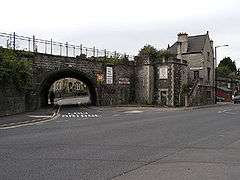Twerton
Twerton is a suburb of the city of Bath, Somerset, England, situated to the west of the city, and home to the city's football club, Bath City.
| Twerton | |
|---|---|
 A view of the closed Twerton-on-Avon railway station. | |
 Twerton Location within Somerset | |
| Population | 5,905 (2011.ward)[1] |
| OS grid reference | ST723642 |
| Unitary authority | |
| Ceremonial county | |
| Region | |
| Country | England |
| Sovereign state | United Kingdom |
| Post town | BATH |
| Postcode district | BA2 |
| Dialling code | 01225 |
| Police | Avon and Somerset |
| Fire | Avon |
| Ambulance | South Western |
| UK Parliament | |
Twerton is served by bus route 5, operated by First West of England buses in the Bath area. For a time, there was a duplicate Wessex Connect service, operating under the name Royal Bath. This was discontinued in the summer of 2013.[2] Wessex Connect does still operate the circular route 20A/C (the suffixes denoting anticlockwise and clockwise services respectively), a route previously operated by First.
Twerton high street[3] houses pubs, a minimarket, a new Morrisons local (as of autumn 2013) formerly Blockbuster, a bakery, and two hairdressing salons.
The Whiteway housing estate is located in the south of the Twerton electoral ward.
History
The Domesday Book of 1086 records that Twerton was held by Nigel de Gournay, who would have won his lands in Englishcombe, Twerton, Swainswick and Barrow Gurney by fighting for William I of England. His original home must have been Gournay, which was half-way between Dieppe and Paris. The parish of Twerton was part of the Wellow Hundred.[4]
Thomas de Gournay was involved with the murder of Edward II at Berkeley Castle in 1327.[5]
At the time when Brunel was designing the Great Western Railway, his plan was for the line from Bath to Bristol to go through the centre of Twerton.[6] The railway station on the main line, called Twerton-on-Avon, survived until 1917. Twerton was also the terminus of one line of the Bath tramway system until that closed in 1939.
St Michael's church was enlarged in 1824 by local architect John Pinch the elder and rebuilt in 1839 by the city architect George Phillips Manners. Twerton Gaol was built by Manners in 1840 and closed in 1878. Only the governor's house survives, now converted into apartments.[7]
The author Henry Fielding who wrote Tom Jones lived in Twerton and is believed to have written most of the novel while living there. His house, Fielding's Lodge, was demolished for road improvements by Bath City Council in 1963.[3]
Housing shortages and population growth after World War II led to significant building of council housing in Twerton and Whiteway, on a much larger scale than elsewhere in Bath. The demographics of the area reflect that fact, with 48% of households in the ward renting from the council or other social housing bodies, and the ward remaining predominantly working class, in contrast to the rest of the city.
The Centurion pub, which was built in 1965, was made a Grade II listed building in 2018.[8]
Geography
Carrs Woodland is a 21.1 hectares (52 acres) local nature reserve in the valley of Newton Brook.[9] It includes the notable bath asparagus.[10] Twerton Roundhill is a 4.66 hectares (11.5 acres) nature reserve of grassland with a range of wildflowers including greater knapweed and agrimony.[11]
References
- "Twerton". UKCrimeStats.com. Retrieved 12 January 2012.
- "Wessex Connect to withdraw Number 5 Service". Twerton Community News. Retrieved 27 September 2013.
- Chapman, Mike (2003). The High Street, Twerton - An historical survey (PDF) (Report). Bath and North East Somerset Council. Retrieved 13 June 2020.
- "Somerset Hundreds". GENUKI. Retrieved 22 October 2011.
- Manco, J. (1995) The Parish of Englishcombe: A History, pp. 2, 4.
- Isambard Kingdom Brunel, a graphic biography by Eugene Byrne and Simon Burr, 2006
- Historic England. "Governor's House (Grade II) (1395132)". National Heritage List for England. Retrieved 22 February 2015.
- "The Centurion Public House". National Heritage List for England. Historic England. Retrieved 10 March 2020.
- "Carrs Woodland Local Nature Reserve, Bath". Avon Local Nature Reserves. Archived from the original on 19 November 2010. Retrieved 23 August 2015.
- "Carrs Woodland". Natural England. Retrieved 23 August 2015.
- "About Roundhill". Friends of Roundhill. Archived from the original on 15 August 2015. Retrieved 26 August 2015.
